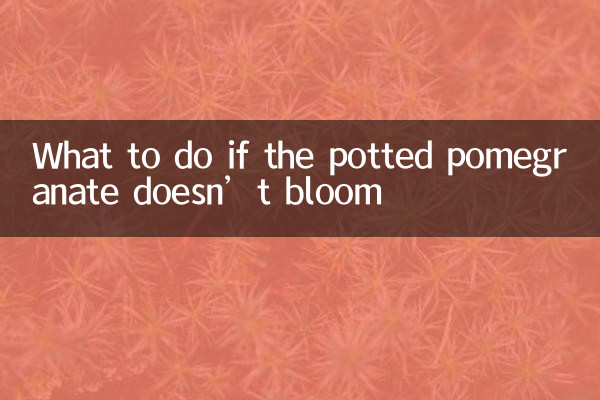What should I do if my potted pomegranate doesn’t bloom? Full analysis of 10 days of popular flower growing problems
In the past 10 days, one of the hot topics that gardening enthusiasts have been paying most attention to is the problem of potted pomegranates not blooming. This article will combine the latest discussion data from the entire network to provide you with a detailed analysis of the reasons and solutions.
1. Ranking of popular gardening topics in the last 10 days

| Ranking | topic | Discussion popularity |
|---|---|---|
| 1 | Potted pomegranate not blooming | 98,542 |
| 2 | Tips for spending summer with succulents | 87,321 |
| 3 | Prevention and treatment of rose black spot disease | 76,543 |
| 4 | Balcony vegetable planting | 65,432 |
| 5 | Hydroponic plant nutrient solution formula | 54,321 |
2. Analysis of the 5 major reasons why potted pomegranates do not bloom
According to statistics from the gardening forum in the past 10 days, the main reasons why potted pomegranates do not bloom are as follows:
| reason | Proportion | Typical symptoms |
|---|---|---|
| Insufficient light | 35% | Leggy branches and leaves, dull leaves |
| Improper fertilization | 28% | Leaves turn yellow or are too dark green |
| Improper pruning | 20% | The branches are messy and there are no new shoots |
| Pot soil problem | 12% | Hardening and poor drainage |
| Breed problem | 5% | Seedling stage or non-ornamental varieties |
3. Five key measures to make potted pomegranates bloom
1.Lighting management: Pomegranate is a sun-loving plant and needs at least 6 hours of direct sunlight every day. It is recommended to place potted plants on a south-facing balcony or windowsill. If the light is insufficient, you can use plant fill lights to assist.
2.Scientific fertilization: Apply nitrogen fertilizer during the budding period in spring to promote the growth of branches and leaves, and apply phosphorus and potassium fertilizer from May to June to promote flower bud differentiation. The following fertilization regimen is recommended:
| period | Fertilizer type | frequency | concentration |
|---|---|---|---|
| March-April | Mainly nitrogen fertilizer | Once every 2 weeks | 0.1% |
| May-June | Mainly phosphorus and potassium fertilizers | 1 time a week | 0.05% |
| July-August | Balanced fertilizer | 1 time per month | 0.05% |
3.Reasonable pruning: Pomegranate flowers bloom on new shoots of the same year and should be pruned appropriately in spring. Keep 3-5 main branches and prune off overly dense branches and weak branches to promote the germination of new shoots.
4.Control water and promote flowers: Appropriate water control during the flower bud differentiation period (May-June) and keeping the pot soil slightly dry can stimulate the plant to produce more flower buds. But be careful to avoid excessive drought leading to leaf fall.
5.winter management: Pomegranate needs a certain amount of low-temperature dormancy to bloom normally. In winter, the ambient temperature should be maintained at 5-10°C for 1-2 months, reduce watering, and stop fertilizing.
4. Frequently Asked Questions
Q: My pomegranate tree is 3 years old, why is it still not blooming?
A: It may be a breed problem or improper maintenance. First confirm whether it is an ornamental variety, and secondly check the lighting, fertilization and other conditions. Generally, potted pomegranates can bloom in 2-3 years.
Q: What should I do if a large number of buds fall off after pomegranate buds appear?
A: This is usually caused by sudden changes in the environment or improper moisture management. Keep the environment stable, avoid moving the potted plants, and keep the soil moist but not too wet during the flowering period.
Q: Can drugs be used to induce flowering?
A: Not recommended. Some flower-stimulating chemicals on the market may be effective in the short term, but they can damage plant health. Promoting flowering by improving maintenance conditions is the safest and most reliable way.
5. Summary
The failure of potted pomegranates to bloom is a problem that gardening enthusiasts have recently reported. Through analysis, it was found that the main reasons focus on maintenance links such as lighting, fertilization, and pruning. As long as you master the growth habits of pomegranates, provide suitable environmental conditions, and maintain them patiently, your potted pomegranates will surely produce beautiful flowers. Remember, plant flowering is a natural result of good growth. Don't rush for success. The key is to improve maintenance methods step by step.

check the details

check the details